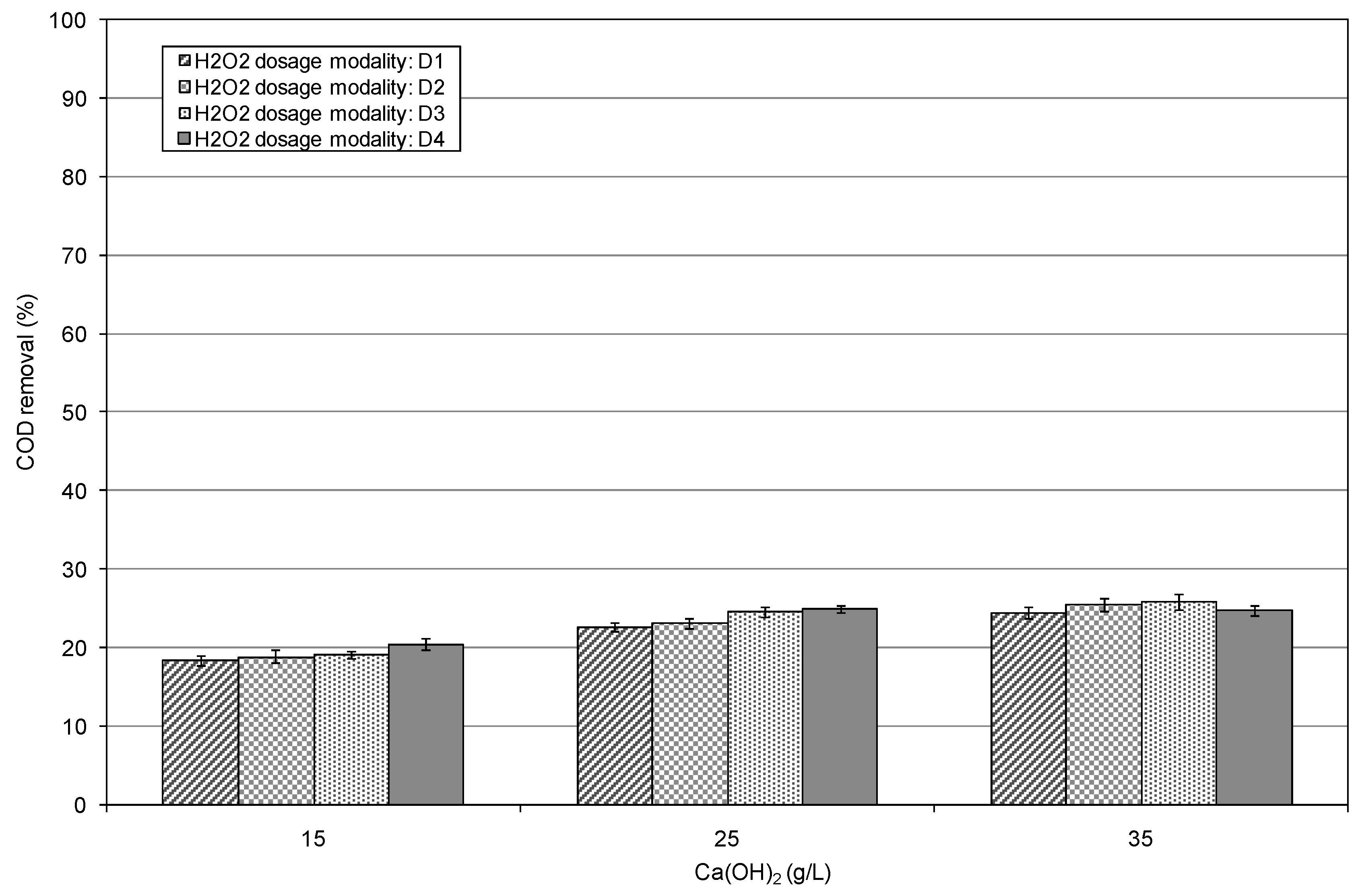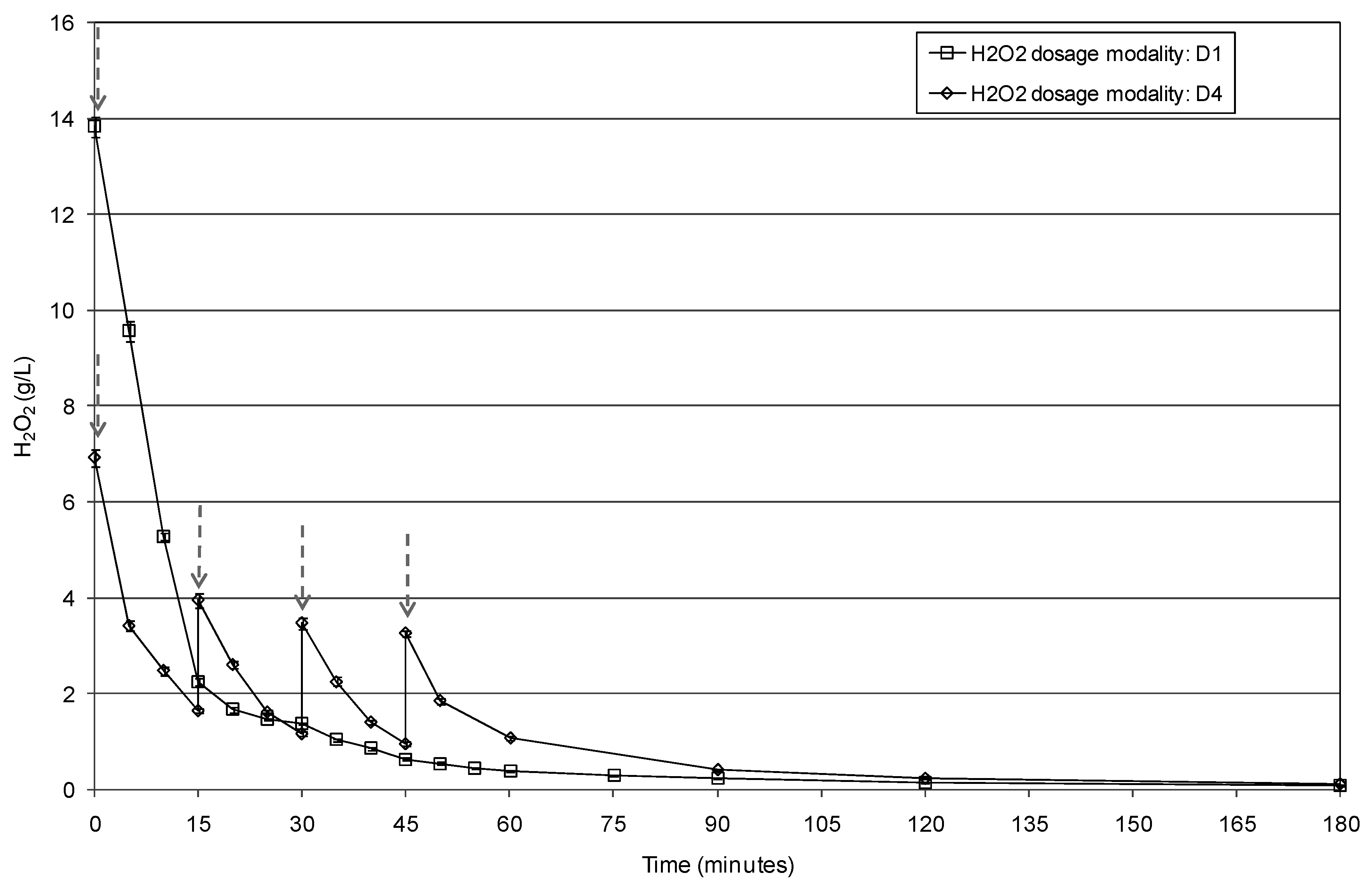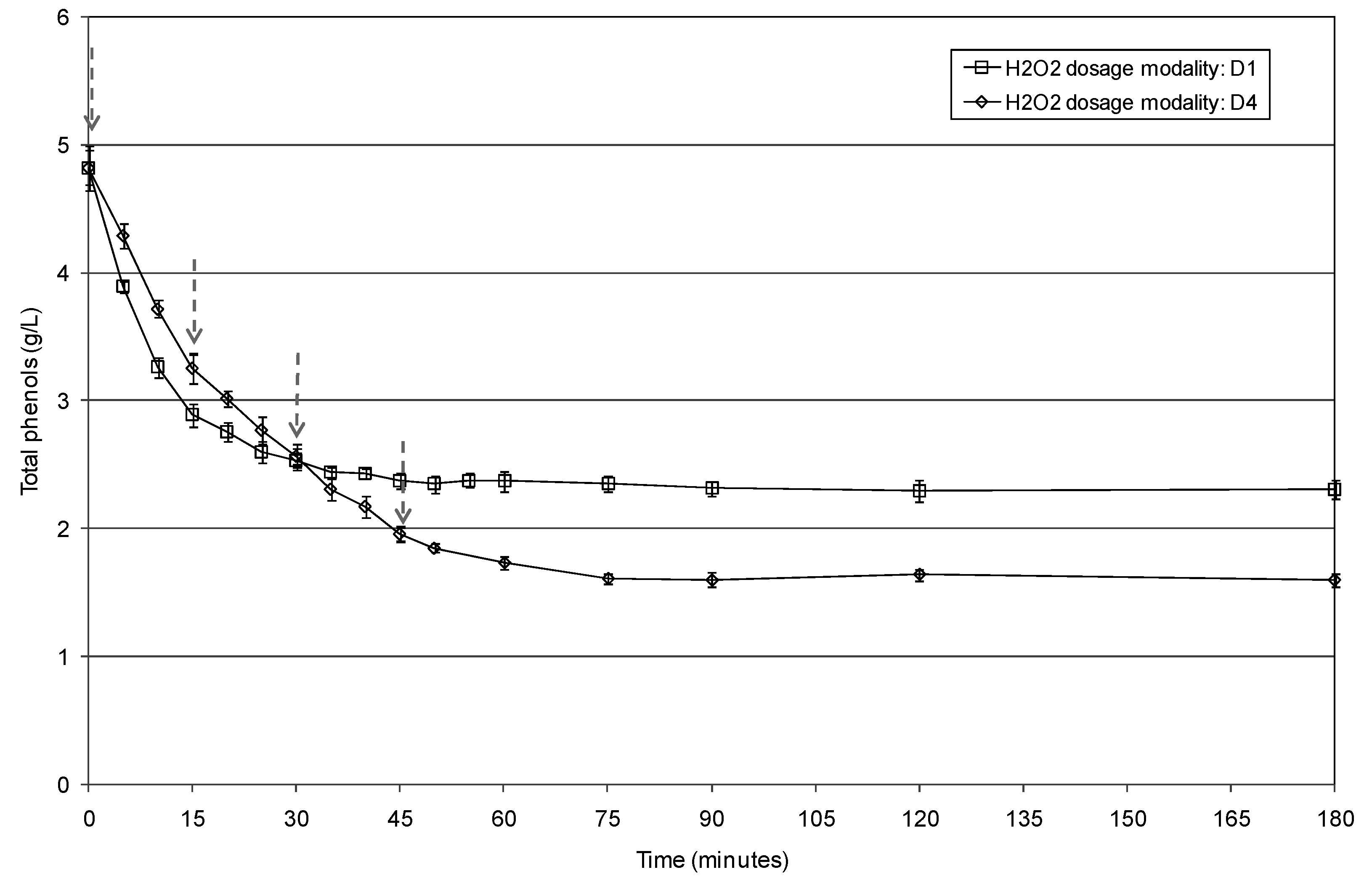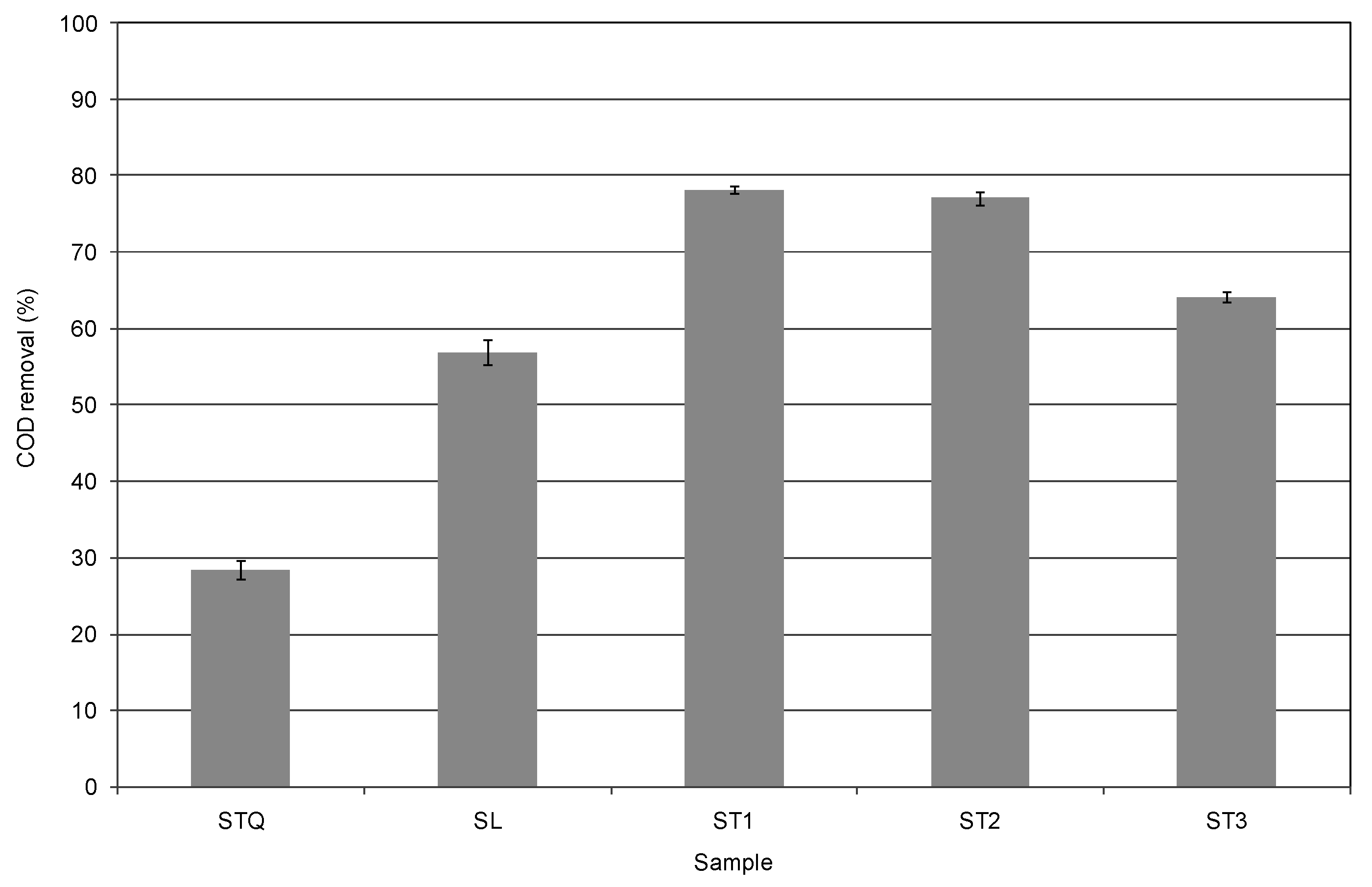Energetic Valorization of Wet Olive Mill Wastes through a Suitable Integrated Treatment: H2O2 with Lime and Anaerobic Digestion
Abstract
:1. Introduction
2. Description of the Experiments
2.1. Materials
2.2. Tests with H2O2 and Ca(OH)2
2.3. Digestion Tests
2.4. Analytical Methods
3. Results and Discussion
3.1. Characteristics of WOMW
3.2. Tests with H2O2 and Ca(OH)2
3.3. Anaerobic Digestion Tests
3.4. Economic Analysis
4. Conclusions
Acknowledgments
Author Contributions
Conflicts of Interest
References
- Lafka, T.-I.; Lazou, A.E.; Sinanoglou, V.J.; Lazos, E.S. Phenolic and antioxidant potential of olive oil mill wastes. Food Chem. 2011, 125, 92–98. [Google Scholar] [CrossRef]
- Martinez-Garcia, G.; Bachmann, R.T.; Williams, C.J.; Burgoyne, A.; Edyvean, R.G.J. Olive oil waste as a biosorbent for heavy metals. Int. Biodeterior. Biodegrad. 2006, 58, 231–238. [Google Scholar] [CrossRef]
- Pintucci, C.; Giovannelli, A.; Traversi, M.L.; Ena, A.; Padovani, G.; Carlozzi, P. Fresh olive mill waste deprived of polyphenols as feedstock for hydrogen photo-production by means of Rhodopseudomonas palustris 42OL. Renew. Energy 2013, 51, 358–363. [Google Scholar] [CrossRef]
- Kougias, P.G.; Kotsopoulos, T.A.; Martzopoulos, G.G. Effect of feedstock composition and organic loading rate during the mesophilic co-digestion of olive mill wastewater and swine manure. Renew. Energy 2014, 69, 202–207. [Google Scholar] [CrossRef]
- Sabbah, I.; Yazbak, A.; Haj, J.; Saliba, A.; Basheer, S. Biomass Selection for Optimal Anaerobic Treatment of Olive Mill Wastewater. Environ. Technol. 2005, 26, 47–54. [Google Scholar] [CrossRef] [PubMed]
- Siciliano, A.; de Rosa, S. Experimental formulation of a kinetic model describing the nitrification process in biological aerated filters filled with plastic elements. Environ. Technol. 2015, 36, 293–301. [Google Scholar] [CrossRef] [PubMed]
- Siciliano, A.; de Rosa, S. An experimental model of COD abatement in MBBR based on biofilm growth dynamic and on substrates’ removal kinetics. Environ. Technol. 2016, 37, 2058–2071. [Google Scholar] [CrossRef] [PubMed]
- Appels, L.; Lauwers, J.; Degrève, J.; Helsen, L.; Lievens, B.; Willems, K.; van Impe, J.; Dewil, R. Anaerobic digestion in global bio-energy production: Potential and research challenges. Renew. Sustain. Energy Rev. 2011, 15, 4295–4301. [Google Scholar] [CrossRef]
- Morillo, J.A.; Antizar-Ladislao, B.; Monteoliva-Sánchez, M.; Ramos-Cormenzana, A.; Russell, N.J. Bioremediation and biovalorisation of olive-mill wastes. Appl. Microbiol. Biotechnol. 2009, 82, 25–39. [Google Scholar] [CrossRef] [PubMed]
- Minh, D.P.; Gallezot, P.; Azabou, S.; Sayadi, S.; le Besson, M. Catalytic wet air oxidation of olive oil mill effluents. Treatment and detoxification of real effluents. Appl. Catal. B Environ. 2008, 84, 749–757. [Google Scholar] [CrossRef]
- El-Gohary, F.A.; Badawy, M.I.; El-Khateeb, M.A.; El-Kalliny, A.S. Integrated treatment of olive mill wastewater (OMW) by the combination of Fenton’s reaction and anaerobic treatment. J. Hazard. Mater. 2009, 162, 1536–1541. [Google Scholar] [CrossRef] [PubMed]
- Ahmadi, M.; Vahabzadeh, F.; Bonakdarpour, B.; Mofarrah, E.; Mehranian, M. Application of the central composite design and response surface methodology to the advanced treatment of olive oil processing wastewater using Fenton’s peroxidation. J. Hazard. Mater. 2005, 123, 187–195. [Google Scholar] [CrossRef] [PubMed]
- Siciliano, A. Use of Nanoscale Zero-Valent Iron (NZVI) Particles for Chemical Denitrification under Different Operating Conditions. Metals 2015, 5, 1507–1519. [Google Scholar] [CrossRef]
- Madani, M.; Aliabadi, M.; Nasernejad, B.; Abdulrahman, R.K.; Kilic, M.Y.; Kestioglu, K. Treatment of olive mill wastewater using physico-chemical and Fenton Processes. Desal. Water Treat. 2015, 53, 2031–2040. [Google Scholar] [CrossRef]
- Siciliano, A. Removal of Cr(VI) from water using a new reactive material: Magnesium Oxide supported nanoscale zero-valent iron. Materials 2016, 9, 666. [Google Scholar] [CrossRef]
- Mert, B.K.; Yonar, T.; Kiliç, M.Y.; Kestioğlu, K. Pre-treatment studies on olive oil mill effluent using physicochemical, Fenton and Fenton-like oxidations processes. J. Hazard. Mater. 2010, 174, 122–128. [Google Scholar] [CrossRef] [PubMed]
- Kılıç, M.Y.; Yonar, T.; Kestioǧlu, K. Pilot-scale treatment of olive oil mill wastewater by physicochemical and advanced oxidation processes. Environ. Technol. 2013, 34, 1521–1531. [Google Scholar] [CrossRef] [PubMed]
- Vilhunen, S.; Puton, J.; Virkutyte, J.; Sillanpää, M. Efficiency of hydroxyl radical formation and phenol decomposition using UV light emitting diodes and H2O2. Environ. Technol. 2011, 32, 865–872. [Google Scholar] [CrossRef] [PubMed]
- Siciliano, A.; Ruggiero, C.; de Rosa, S. A new integrated treatment for the reduction of organic and nitrogen loads in methanogenic landfill leachates. Process Saf. Environ. Prot. 2013, 91, 311–320. [Google Scholar] [CrossRef]
- Drouiche, M.; Le Mignot, V.; Lounici, H.; Belhocine, D.; Grib, H.; Pauss, A.; Mameri, N. A compact process for the treatment of olive mill wastewater by combining UF and UV/ H2O2 techniques. Desalination 2004, 169, 81–88. [Google Scholar] [CrossRef]
- Atanassova, D.; Kefalas, P.; Petrakis, C.; Mantzavinos, D.; Kalogerakis, N.; Psillakis, E. Sonochemical reduction of the antioxidant activity of olive mill wastewater. Environ. Int. 2005, 31, 281–287. [Google Scholar] [CrossRef] [PubMed]
- Bettazzi, E.; Morelli, M.; Caffaz, S.; Caretti, C.; Azzari, E.; Lubello, C. Olive mill wastewater treatment: An experimental study. World Water Congr. 2006, 54, 17–25. [Google Scholar] [CrossRef]
- Canepa, P.; Cauglia, F.; Caviglia, P.; Chelossi, E. Photo-Fenton Oxidation of Oil Mill Waste Water. Environ. Sci. Pollut. Res. 2003, 10, 217–220. [Google Scholar] [CrossRef]
- Giordano, G.; Perathoner, S.; Centi, G.; de Rosa, S.; Granato, T.; Katovic, A.; Siciliano, A.; Tagarelli, A.; Tripicchio, F. Wet hydrogen peroxide catalytic oxidation of olive oil mill wastewaters using Cu-zeolite and Cu-pillared clay catalysts. Catal. Today 2007, 124, 240–246. [Google Scholar] [CrossRef]
- Khoufi, S.; Aloui, F.; Sayadi, S. Treatment of olive oil mill wastewater by combined process electro-Fenton reaction and anaerobic digestion. Water Res. 2006, 40, 2007–2016. [Google Scholar] [CrossRef] [PubMed]
- De Rosa, S.; Siciliano, A. A catalytic oxidation process of olive oil mill wastewaters using hydrogen peroxide and copper. Desal. Water Treat. 2010, 23, 187–193. [Google Scholar] [CrossRef]
- Esplugas, S.; Giménez, J.; Contreras, S.; Pascual, E.; Rodrìguez, M. Comparison of different advanced oxidation processes for phenol degradation. Water Res. 2002, 36, 1034–1042. [Google Scholar] [CrossRef]
- Kotta, E.; Kalogerakis, N.; Mantzavinos, D. The effect of solids on the electrochemical treatment of olive mill effluents. J. Chem. Technol. Biotechnol. 2007, 82, 504–511. [Google Scholar] [CrossRef]
- Iboukhoulef, H.; Amrane, A.; Kadi, H. Microwave-enhanced Fenton-like system, Cu(II)/H2O2, for olive mill wastewater treatment. Environ. Technol. 2013, 34, 853–860. [Google Scholar] [CrossRef] [PubMed]
- Siciliano, A.; Stillitano, M.A.; de Rosa, S. Increase of the anaerobic biodegradability of olive mill wastewaters through a pre-treatment with hydrogen peroxide in alkaline conditions. Desal. Water. Treat. 2014, 55, 1735–1746. [Google Scholar] [CrossRef]
- Siciliano, A.; Stillitano, M.A.; de Rosa, S. Biogas production from wet olive mill wastes pretreated with hydrogen peroxide in alkaline conditions. Renew. Energy 2016, 85, 903–916. [Google Scholar] [CrossRef]
- American Public Health Association. Standard Methods for the Examination of Water and Wastewater, 20th ed.; American Public Health Association and Water Environment Federation: Washington, DC, USA, 1998. [Google Scholar]
- Folin, O.; Ciocalteu, V. On tyrosine and tryptofan determination in protein. J. Biol. Chem. 1927, 73, 627–650. [Google Scholar]
- Mantzavinos, D. Removal of benzoic acid derivates from aqueous effluents by the catalytic decomposition of hydrogen peroxide. Process Saf. Environ. Prot. 2003, 81, 99–106. [Google Scholar] [CrossRef]
- Aktas, E.S.; Imre, S.; Ersoy, L. Characterization and lime treatment of olive mill wastewater. Water Res. 2001, 35, 2336–2340. [Google Scholar] [CrossRef]
- Uǧurlu, M.; İbrahim, K. Decolourization and Removal of Some Organic Compounds from Olive Mill Wastewater by Advanced Oxidation Processes and Lime Treatment. Env. Sci. Pollut. Res. 2007, 14, 319–325. [Google Scholar] [CrossRef]
- Sabbah, I.; Marsook, T.; Basheer, S. The effect of pretreatment on anaerobic activity of olive mill wastewater using batch and continuous systems. Process Biochem. 2004, 39, 1947–1951. [Google Scholar] [CrossRef]
- Hamdi, M. Toxicity and biodegradability of olive mill wastewaters in batch anaerobic digestion. Hum. Press Inc. 1992, 37, 155–163. [Google Scholar] [CrossRef]
- Khanal, S. Anaerobic Biotechnology for Bioenergy Production: Principles and Applications; Wiley-Blackwell: Ames, IA, USA, 2008. [Google Scholar]
- Metcalf & Eddy. Wastewater Engineering: Treatment and Reuse, 4th ed.; McGraw-Hill: New York, NY, USA, 2003. [Google Scholar]
- Siciliano, A.; de Rosa, S. Recovery of ammonia in digestates of calf manure through a struvite precipitation process using unconventional reagents. Environ. Technol. 2014, 35, 841–850. [Google Scholar] [CrossRef] [PubMed]
- Siciliano, A. Assessment of fertilizer potential of the struvite produced from the treatment of methanogenic landfill leachate using low-cost reagents. Environ. Sci. Pollut. Res. 2016, 23, 5949–5959. [Google Scholar] [CrossRef] [PubMed]
- Albuquerque, J.A.; de la Fuente, C.; Ferrer-Costa, A.; Carrasco, L.; Cegarra, J.; Abad, M.; Bernal, M.P. Assessment of the fertilizer potential of digestates from farm and agroindustrial residues. Biomass Bioenergy 2012, 40, 181–189. [Google Scholar] [CrossRef]







| pH | Cond. mS/cm | COD g/L | TP g/L | VFA g/L | ALK g/L |
| 4.41 ± 0.11 | 10.0 ± 0.26 | 276.7 ± 0.86 | 4.85 ± 0.10 | 4.39 ± 0.11 | 1.84 ± 0.04 |
| TKN g/L | NH4+-N g/L | PO4−3-P g/L | TS g/L | VS g/L | |
| 1.89 ± 0.07 | 0.18 ± 0.006 | 0.39 ± 0.012 | 337.5 ± 1.35 | 317.6 ± 1.41 |
| Sample | pH | Cond. mS/cm | COD g/L | TP g/L | VFA g/L | ALK g/L |
| LM | 7.72 ± 0.09 | 8.81 ± 0.30 | 121.8 ± 1.46 | 1.59 ± 0.06 | 6.02 ± 0.21 | 11.1 ± 0.3 |
| LMD | 7.90 ± 0.12 | 18.3 ± 0.27 | 35.45 ± 1.27 | 1.38 ± 0.02 | 2.64 ± 0.10 | 19.7 ± 0.37 |
| Sample | TKN g/L | NH4+-N g/L | PO4−3-P g/L | TS g/L | VS g/L | |
| LM | 2.54 ± 0.09 | 1.67 ± 0.047 | 0.532 ± 0.021 | 60.9 ± 0.78 | 44.2 ± 1.12 | |
| LMD | 1.95 ± 0.052 | 1.5 ± 0.038 | 0.52 ± 0.020 | 40.7 ± 0.56 | 27.5 ± 0.98 |
| Progressive Dosing Time of H2O2 (min) | 0 | 15 | 30 | 45 | |
|---|---|---|---|---|---|
| H2O2 quantity (gH2O2/gCOD) | modality D1 | 0.05 | 0 | 0 | 0 |
| modality D2 | 0.025 | 0.025 | 0 | 0 | |
| modality D3 | 0.025 | 0.0125 | 0.0125 | 0 | |
| modality D4 | 0.025 | 0.0083 | 0.0083 | 0.0083 | |
| Sample | pH | Cond. mS/cm | COD g/L | TP g/L | VFA g/L | ALK g/L | VFA/ALK g/g |
| STQ | 7.11 ± 0.06 | 11.9 ± 0.26 | 189.5 ± 1.56 | 3.65 ± 0.08 | 4.44 ± 0.11 | 16.84 ± 0.42 | 0.26 ± 0.009 |
| SL | 8.12 ± 0.11 | 12.9 ± 0.40 | 176.9 ± 1.94 | 1.98 ± 0.02 | 4.52 ± 0.12 | 26.71 ± 0.96 | 0.17 ± 0.007 |
| ST1 | 7.33 ± 0.09 | 13.2 ± 0.47 | 149.6 ± 1.34 | 1.69 ± 0.05 | 4.69 ± 0.19 | 19.15 ± 0.40 | 0.245 ± 0.01 |
| ST2 | 7.47 ± 0.07 | 13.9 ± 0.26 | 146.5 ± 1.89 | 1.43 ± 0.03 | 5.88 ± 0.10 | 26.50 ± 0.79 | 0.220 ± 0.007 |
| ST3 | 7.54 ± 0.07 | 14.3 ± 0.53 | 144.6 ± 1.12 | 1.10 ± 0.02 | 6.93 ± 0.17 | 33.51 ± 0.60 | 0.206 ± 0.006 |
| Sample | TKN gN/L | NH4+-N g/L | PO4−3-P g/L | COD/TKN g/g | TS g/L | VS g/L | |
| STQ | 2.02 ± 0.038 | 0.70 ± 0.027 | 0.46 ± 0.011 | 93.8 ± 1.92 | 201.6 ± 1.01 | 190.1 ± 1.21 | |
| SL | 1.98 ± 0.06 | 0.19 ± 0.003 | 0.16 ± 0.006 | 89.3 ± 2.87 | 202.3 ± 0.95 | 192.1 ± 1.45 | |
| ST1 | 1.91 ± 0.07 | 0.18 ± 0.002 | 0.22 ± 0.007 | 78.3 ± 2.90 | 201.9 ± 1.4 | 189.4 ± 1.62 | |
| ST2 | 1.96 ± 0.07 | 0.20 ± 0.002 | 0.15 ± 0.005 | 74.7 ± 2.83 | 202.6 ± 1.1 | 189.1 ± 0.86 | |
| ST3 | 1.88 ± 0.06 | 0.16 ± 0.003 | 0.15 ± 0.003 | 76.9 ± 2.52 | 203.4 ± 1.8 | 189.0 ± 0.74 |
| Sample | pH | Cond. mS/cm | COD g/L | CH4/CODr L/g | TP g/L | VFA g/L | ALK g/L |
| STQ | 7.56 ± 0.11 | 13.1 ± 0.37 | 135.6 ± 2.03 | 0.03 ± 0.001 | 3.60 ± 0.039 | 3.50 ± 0.084 | 6.70 ± 0.16 |
| SL | 7.95 ± 0.08 | 13.36 ± 0.41 | 76.19 ± 2.74 | 0.24 ± 0.015 | 1.95 ± 0.035 | 1.61 ± 0.034 | 14.14 ± 0.23 |
| ST1 | 7.89 ± 0.07 | 13.69 ± 0.29 | 32.60 ± 0.55 | 0.34 ± 0.003 | 1.56 ± 0.021 | 1.56 ± 0.019 | 11.35 ± 0.41 |
| ST2 | 7.76 ± 0.11 | 14.31 ± 0.39 | 33.50 ± 1.23 | 0.35 ± 0.014 | 1.40 ± 0.027 | 1.25 ± 0.03 | 15.76 ± 0.67 |
| ST3 | 7.95 ± 0.012 | 15.73 ± 0.47 | 51.95 ± 0.88 | 0.33 ± 0.008 | 1.07 ± 0.019 | 1.04 ± 0.011 | 18.34 ± 0.75 |
| Sample | TKN g/L | NH4+-N g/L | PO4−3-P g/L | COD/TKN g/g | TS g/L | VS g/L | |
| STQ | 1.92 ± 0.058 | 0.74 ± 0.02 | 0.150 ± 0.005 | 70.62 ± 2.4 | 185.6 ± 2.04 | 171.1 ± 1.98 | |
| SL | 1.29 ± 0.033 | 0.63 ± 0.024 | 0.074 ± 0.003 | 59.06 ± 2.6 | 118.7 ± 1.54 | 94.3 ± 1.64 | |
| ST1 | 1.06 ± 0.025 | 0.82 ± 0.031 | 0.067 ± 0.002 | 33.95 ± 0.89 | 70.8 ± 1.13 | 56.4 ± 0.97 | |
| ST2 | 1.16 ± 0.019 | 0.84 ± 0.024 | 0.105 ± 0.003 | 28.87 ± 1.16 | 68.9 ± 1.25 | 55.9 ± 0.45 | |
| ST3 | 1.04 ± 0.014 | 0.79 ± 0.028 | 0.086 ± 0.001 | 49.95 ± 1.08 | 74.6 ± 1.48 | 67.9 ± 1.01 |
© 2016 by the authors; licensee MDPI, Basel, Switzerland. This article is an open access article distributed under the terms and conditions of the Creative Commons Attribution (CC-BY) license (http://creativecommons.org/licenses/by/4.0/).
Share and Cite
Siciliano, A.; Stillitano, M.A.; Limonti, C. Energetic Valorization of Wet Olive Mill Wastes through a Suitable Integrated Treatment: H2O2 with Lime and Anaerobic Digestion. Sustainability 2016, 8, 1150. https://doi.org/10.3390/su8111150
Siciliano A, Stillitano MA, Limonti C. Energetic Valorization of Wet Olive Mill Wastes through a Suitable Integrated Treatment: H2O2 with Lime and Anaerobic Digestion. Sustainability. 2016; 8(11):1150. https://doi.org/10.3390/su8111150
Chicago/Turabian StyleSiciliano, Alessio, Maria Assuntina Stillitano, and Carlo Limonti. 2016. "Energetic Valorization of Wet Olive Mill Wastes through a Suitable Integrated Treatment: H2O2 with Lime and Anaerobic Digestion" Sustainability 8, no. 11: 1150. https://doi.org/10.3390/su8111150








